Each year Mike Nicklin and Simon Bishop at Explorer Motorhomes make improvements to the models in their line-up; the slide-on Frontier Backpack, the midstream Compass, and their flagship, the Navigator.
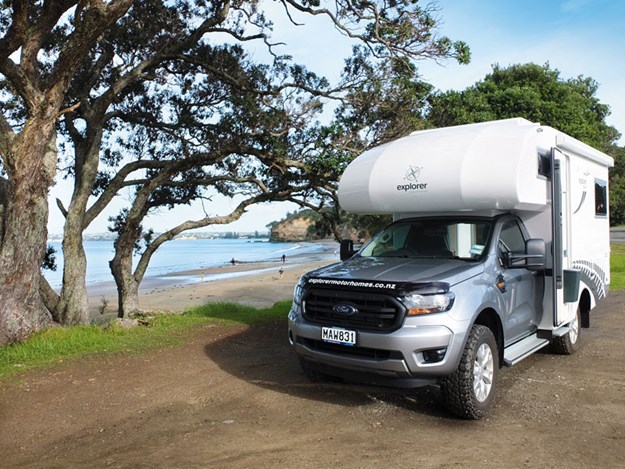
Some are big upgrades while others are small, but all are important to the long-term goal of making Explorer motorhomes the best they can be. While not immediately noticeable, this year’s improvements to the Navigator are significant.
Explorer were keen to increase the payload on their Navigator range. They went to Pedder, Australia’s No.1 brake and suspension specialists. Pedder had developed a suspension upgrade kit that increased the GVW of the Ford Ranger cab chassis from 3200kg to 3500kg, just what Explorer wanted.
The job of fitting the kit, replacing the original springs, shock absorbers and shackles with upgraded parts is carried out by Explorer staff trained for the task, under the watchful eye of Simon, an approved installer. The result is not just a better GVM, but also an increased load rating for the rear axle, giving the Navigator much improved payload capacity.
Ford in Australia and the Australian Federal Government both approved the Pedder upgrade kit and so have the NZ Transport Authority and the Low Volume Vehicle Technical Association (Inc) in New Zealand. The compliance plates of Navigator Rangers modified in this way show details of the suspension upgrade.
All set for off-grid
For more than a year Explorer have offered the REDARC vehicle management system on their motorhomes. It has a DC-to-DC battery charger that is designed to work with ‘smart’ alternators now fitted to the majority of new vehicles and can charge all battery types including calcium and lithium.
A system management unit, the ‘Manager30’, operates like six separate products; a DC-to-DC battery charger when the vehicle is on the move, a 240-volt 30-amp mains charger, a 30-amp MPPT solar regulator, a starting battery isolator, a load disconnect controller and a remote battery monitor for up-to-date battery information and charge status. This data can be viewed on the 4.3-inch display unit.
Taking advantage of the REDARC Manager30’s ability to charge and manage lithium batteries, Explorer now offer 100 amp/hr and 160 amp/hr lithium batteries from Revolution Power Australia. These are top-of-the-line user-friendly products offering many benefits, particularly for those who enjoy travelling ‘off the grid’.
They are smaller and lighter and can endure up to 10 times more charge cycles than the equivalent sized lead acid battery. They can cope with being discharged up to 100 percent, and with a suitable charger they can be recharged in three to four hours.
Exterior
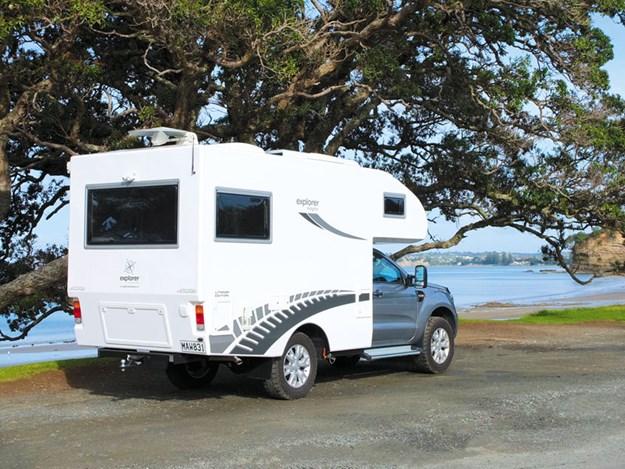
Outside, the Navigator is pretty much the same. Below each cab door is a step to ease the way in and out. Explorer recommends fitting these steps as they do such a good job protecting the bodywork. Clearview side mirrors are fitted and they certainly provide an excellent view to the rear.
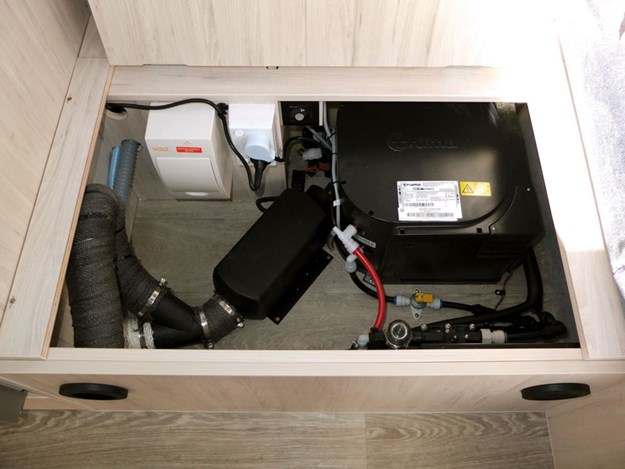 |
Both the water and space heater are under the side settee |
Kerbside on the side wall is an optional fold-down outdoor table that is very handy at barbecue time. Beside that is the LPG bottle locker. The LPG bottle is a weight-saving 5kg alloy model. My initial reaction was ‘that’s a bit small’ – until I remembered the fridge doesn’t use LPG; it is a 12-volt compressor type. The LPG is for the water heater and the stove. Looking down from above is an optional Fiamma three-metre awning.
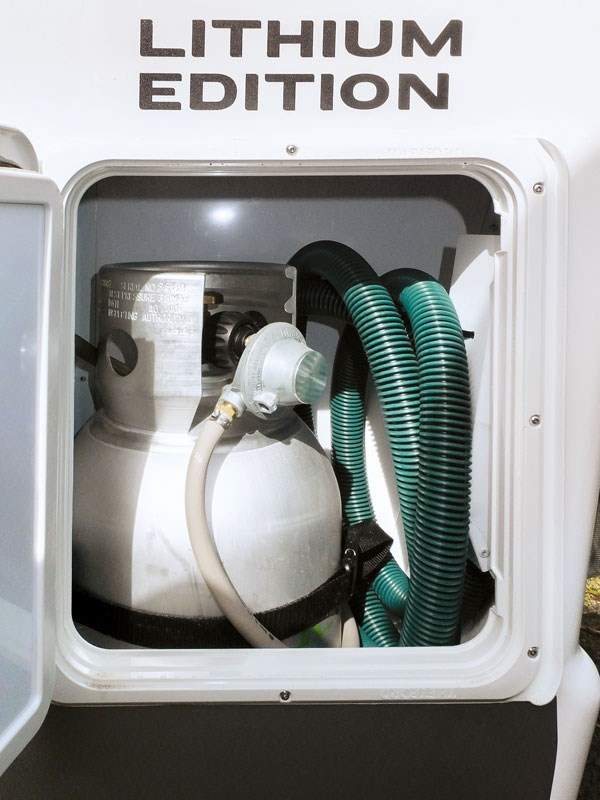 |
The lightweight alloy 5kg LPG bottle |
The rear panel has a wide door locker at the bottom with an optional outside shower point alongside. Fitted below the skirt is the optional towbar. Above the window are optional twin cameras for reversing. Driver’s side you’ll find a rear locker hatch, the fresh water fill points and the toilet cassette hatch.
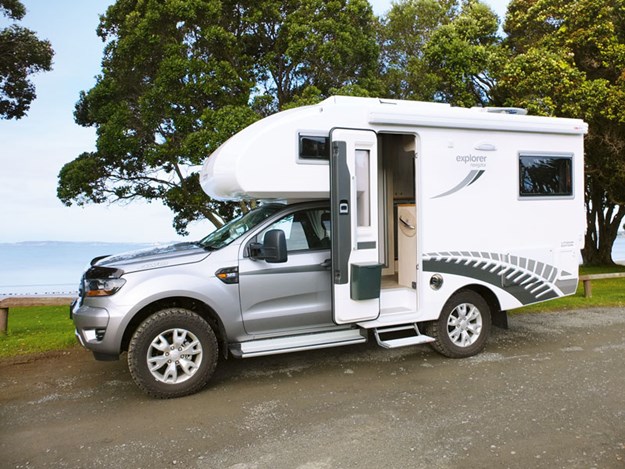 |
The Navigator is distinguished by the Luton over the cab and the stylised silver fern |
Tucked under the skirt by the wheel arch is the grey water discharge pipe. Explorer recommends fitting the optional alloy wheels seen here as they can accommodate off-road GT Radial light truck tyres. The Navigator has a distinctive appearance, with the Luton over the cab and the stepped-in rear panel all tied together by the stylised silver fern leaf down the side.
Interior
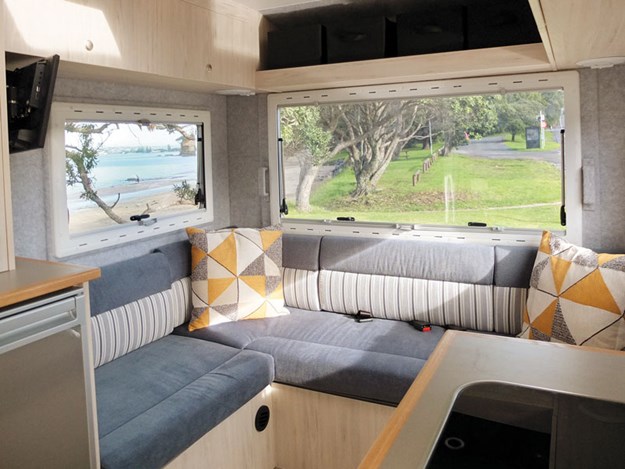 |
The lounge is also used as a dining room and second bedroom |
Inside, the layout has the cab with the Luton above to the left, bathroom straight ahead, kitchen to the right and the lounge at the rear. The lounge is a multi-purpose space as it also serves as a dining room and, if necessary, a bedroom once the seat cushions have been rearranged to form the bed.
Quality cushions can be the making of a sale, and these Starfish ones, with their sculpted back cushions, straight seams and tight fit, make an excellent first impression. A novel improvement here are the boards that form the bed base between the settees.
They stow away vertically, out of sight, taking up no room at all and easily retrieved when needed. The dining table stows away behind the passenger seat, held in place by part of the step used to access the Luton bed over the cab.
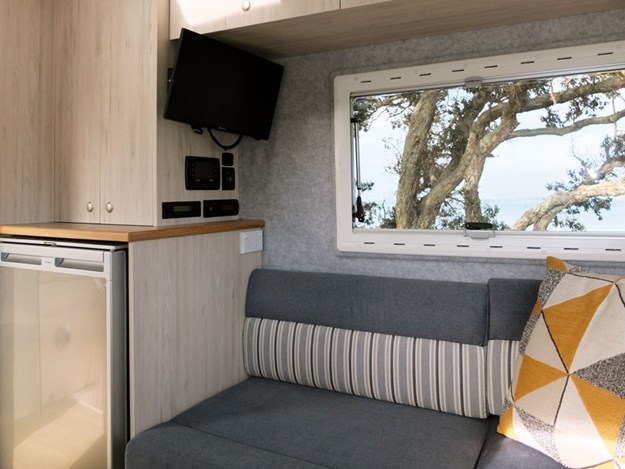 |
Radio and TV controls are conveniently grouped together |
Two headrests are mounted on an upholstered bar above two seat-belted rear seats. When there are no passengers, the headrest bar can be removed. The TV (optional) is mounted above the fridge. On the roof is the optional NZSAT auto satellite aerial. A radio with stereo speakers is standard. The speakers, mounted above the settees, are fitted with LED reading lights.
Storage under the rear settees is limited to the space under the kerbside one. Beneath the rear settee is an external locker, and the space under the other side settee is home to the water and space heaters.
Kitchen
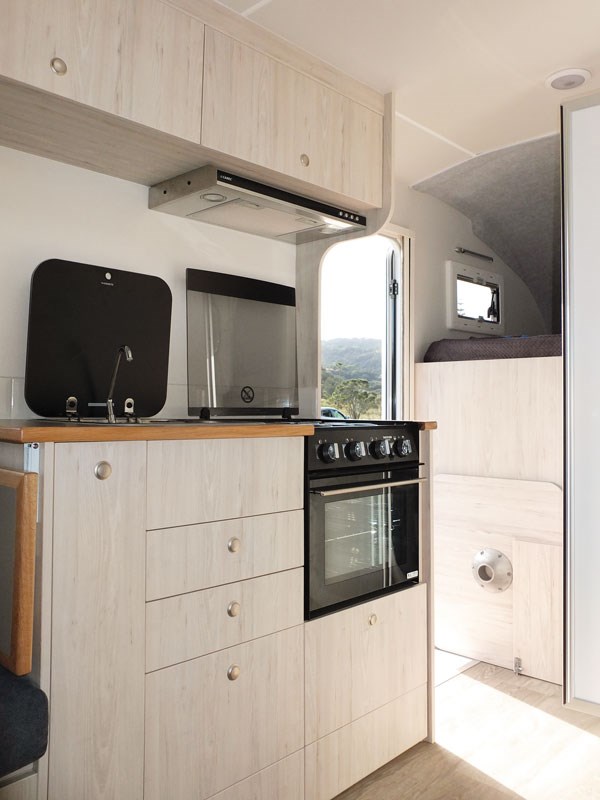 |
The kitchen has plenty of storage and workspace |
Considering the size of the Navigator, it has a relatively spacious kitchen. The Thetford Triplex has a full oven with a three-LPG hob cooktop. Above is a Camec ducted rangehood. The sink has a fold-down faucet, allowing the sink cover to fold flat.
With the lids lowered and the bench extension up, the benchtop measures a good 1500mm long. Four large drawers below the benchtop plus five overhead lockers provide ample room for supermarket shopping.
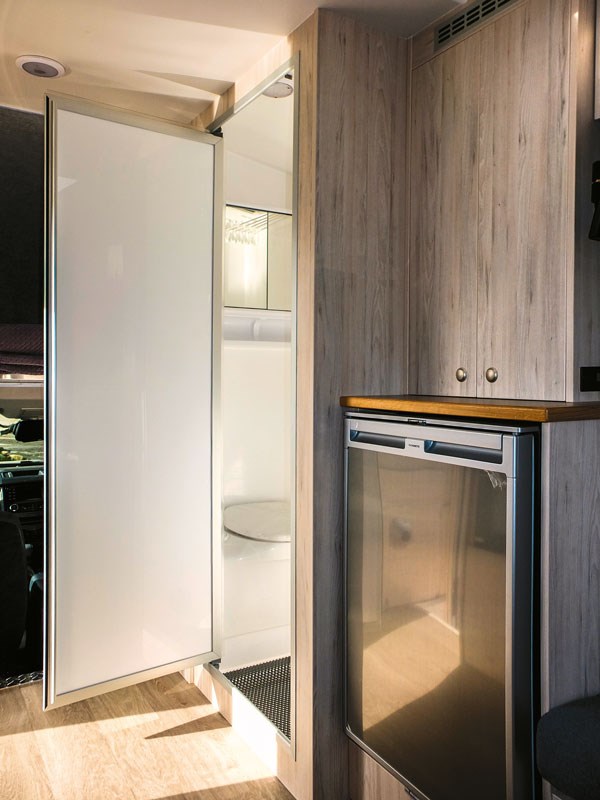 |
The 136-litre Waeco fridge |
Opposite is the 240-volt/12-volt two-way, 136-litre Waeco fridge with a freezer compartment. Moving the fridge off LPG extends the LPG bottle life. Having 300 watts of solar panels with a 160amp/hr lithium house battery provides more than enough 12-volt power to keep food and beverages cold.
Bathroom
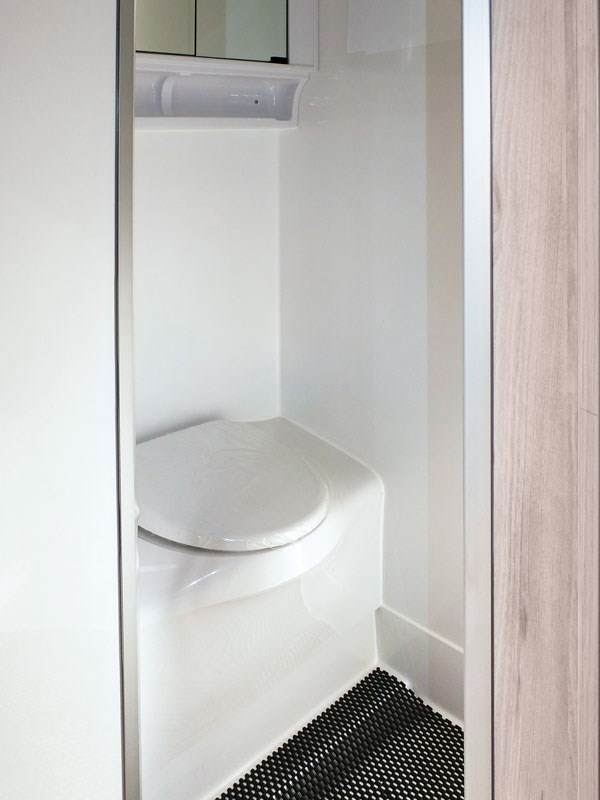 |
The handbasin is opposite the toilet |
The bathroom is definitely compact; just the width of a Thetford C402C electric flush toilet (around 670mm x 900mm), with its own separate flush water reservoir. With a moulded acrylic lining and a moulded corner basin unit, the bathroom is easily cleaned.
The shower handpiece is mounted on a wall rail. A wall cabinet provides storage for toiletries and there is a hatch in the ceiling. It’s not quite ‘blink and you miss it’, but you know what I mean.
Bedroom
Funnily enough, it is the Luton bed that makes the Navigator interior seem so spacious. It is lower than most Lutons and is more like another item of furniture instead of a bed at the top of a ladder. One step up and you get to sit on the bed, no problem.
Fitted with a Starfish foam mattress and breathable base, it promises sweet dreams and a restful night. There is an LED reading light and an opening window each end of the bed so you can choose which way around you want to sleep.
Adequate headroom allows sitting up and reading in bed, and a pair of curtains provides privacy when needed. It is a generous size, too, at 1950mm long x 1350mm wide.
Access through to the cab can be a scramble, but it probably gets easier on a cold, wet and windy day.
All Explorer motorhomes are sold fully compliant with a Certificate of Compliance (LPG), an Electrical Warrant of Fitness, Certified Self Contained (CSC), Low Volume Certification and a Warrant of Fitness.
While you can hit the road with all the basics needed to ‘go bush’, there is a suite of additional items you can choose from to personalise your Navigator with features that are important to you. Explorer claim all Navigator models built so far have been different.
This ‘personalisation’ of their motorhomes is an important factor in Explorer’s success story. How successful? Well if you order one today you can expect delivery around the middle of next year.
The Navigator is built on a Ranger cab/chassis with a five-cylinder motor through a six-speed auto transmission and part-time with high/low ratio. The starting price for an Explorer Navigator on a Ford Ranger cab/chassis is $149,000.
For more information visit explorermotorhomes.co.nz or call Simon and Mike on 0800 227144
Pros:
- The upgraded suspension.
- The REDARC Total Vehicle Management System.
- The concept of an affordable motorhome body on an off-road chassis.
Cons:
- Nill
Navigator by explorer specifications
Vehicle make/model | Navigator by Explorer |
Length overall | 5900mm |
Width overall | 2080 mm |
Height overall | 3000 mm plus sat. dish |
Maximum headroom | 1940 mm |
GVW kg | 3500 |
Tare kg | 2950 |
Payload kg | 550 |
Type | Cab/chassis |
Berths | 4-berth |
Approved seating | 4 |
Licence to drive | Class 1. (Car licence) |
Engine | 5-cylinder 3.2L turbo diesel |
Power | 147kW |
Torque | 470Nm |
Gearbox | 6-speed auto |
Fresh /Grey water | 95/80L (monitored) |
Solar Panels | 2 x 150-watt |





